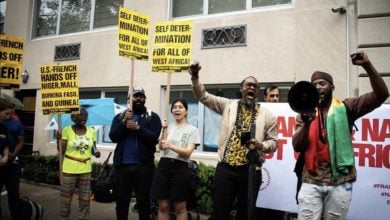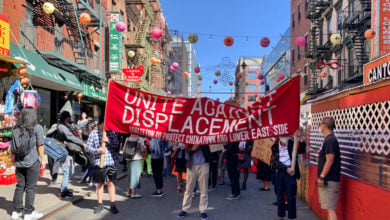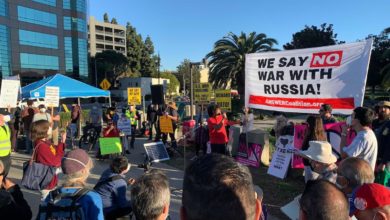 North Vietnamese soldiers push trucks along the Ho Chi Minh trail. Photo: Lam Tan Tai |
Vietnam was reunited after three decades of war as the Socialist Republic of Vietnam. Saigon was renamed Ho Chi Minh City, in honor of the central leader of the Vietnamese revolution, who did not live to see the final victory.
It wasn’t just the end of another puppet government. The outcome of the Vietnam War definitively shattered the myth of U.S. imperialist invincibility.
The world’s leading military power had suffered its first decisive military defeat in its two centuries of existence. Defeat had been inflicted not by another “great power,” but instead by a poor country of 40 million people struggling to emerge from the legacy of colonialism and devastating poverty. Not only did the Vietnamese defeat the United States, they had earlier vanquished another major imperialist power and former colonizer, France.
The Vietnamese paid an unimaginable price for their victory. Between 1945 and 1975, between 7.2 and 7.7 million Vietnamese died at the hands of Japanese, French and U.S. occupiers.
When the last U.S. troops finally left, 9,000 of South Vietnam’s 15,000 villages had been destroyed. In the north, all six of the industrial cities and 4,000 of 5,800 agricultural communes were badly damaged. Twenty-one million gallons of Agent Orange herbicide had been sprayed on the country, mostly in the south, destroying vast areas and causing a huge rise in birth defects and cancer.
In the south, there were hundreds of thousands of orphans, one million widows and more than 200,000 prostitutes. The legacy of war was exacerbated by U.S. economic sanctions on Vietnam that lasted for more than two decades after the country’s liberation.
How did Vietnam win? How could the Vietnamese overcome what appeared in every respect to be insuperable odds and catastrophic losses and defeat U.S. imperialism?
Weighing the relative wealth, power and technology of the sides in the struggle, it seemed unthinkable that Vietnam could triumph. That’s certainly how directors of U.S. foreign policy under Presidents Kennedy, Johnson and Nixon in the 1960s and 1970s saw it.
An astonishing achievement
Stricken with disbelief at their defeat, some of the die-hard supporters of the war claimed that the United States lost only because it “fought with one hand tied behind its back.” This was a reference to the fact that the Pentagon was not given the green light to drop nuclear bombs on Vietnam. It was about the only weapon that the U.S. military did not employ. What held them back had nothing to do with either weakness or morality. They feared a global social explosion.
Vietnam’s victory ranks as one of the most astonishing achievements in history. It can be attributed to material factors and human consciousness; above all to the iron determination, superior organization, and revolutionary leadership of the Vietnamese liberation movement and Communist Party. The existence of a revolutionary Marxist party and leadership was crucial in guiding the Vietnamese people’s national liberation struggle to victory.
The Vietnamese revolutionary forces received crucial assistance from the then-existing socialist camp, and essential solidarity from a global anti-war movement. Inside the United States, that movement grew to encompass millions of people, including a sizable part of the occupier’s own military.
So many U.S. soldiers had gone AWOL (absent without leave) by 1970 that the generals feared their army was collapsing. Many Vietnam veterans became the most impassioned opponents of a war whose atrocities they had seen first-hand—and sometimes participated in.
Vietnamese resistance to French colonialism
The people of Vietnam have had a long and well-documented tradition of resisting powerful occupying powers. For several centuries, the main struggle was against conquest by the Chinese empire. Modern colonialism began with the arrival of the French in the 1850s. French rule was gradually extended to all of Indochina—Laos, Cambodia and Vietnam.
French imperialism ruthlessly exploited its new colonies in Southeast Asia. In plantations, mines and rice fields, conscripted laborers were worked to death. French settlers—and a very thin layer of Vietnamese feudal landowners and puppet officials—lived in luxury, while conditions of life worsened for the masses of people. Vietnam became a major rice exporter, while domestic rice consumption declined.
Social programs were underfunded and ignored by the colonizers. Illiteracy rose by an estimated 80 percent under French colonial rule.
On Sept. 2, 1945, Ho Chi Minh declared Vietnam’s independence to an assembly of more than 500,000 people. He indicted the French colonizers: “In the field of politics, they have deprived our people of every democratic liberty. … They have enforced inhuman laws; they have set up three distinct political regimes in the North, the Center and the South … in order to wreck our national unity and prevent our people from being united. They have built more prisons than schools. They [have] mercilessly slain our patriots; they drowned our uprisings in rivers of blood. … They have robbed us of our rice fields, our mines, our forests and our raw materials.”
 Ho Chi Minh Photo: Marc Riboud |
Born in 1890, Ho Chi Minh—earlier known as Nguyen Ai Quoc—was the founding leader of the Indochinese Communist Party, organized in Hong Kong in 1930. Ho had earlier been a founding member of the French Communist Party (PCF) when it split from the Socialist Party of France a decade earlier. The position of Lenin and the Bolshevik Party on supporting the right of oppressed nations to self-determination was key in winning him over. The socialist parties in imperialist countries supported the continuation of colonial rule in many cases. They often became administrators of colonialism when they were elected to government.
During the 1920s, Ho wrote for the PCF’s newspaper, L’Humanite. Among his writings were very insightful columns on the Ku Klux Klan and the struggle against racism and national oppression in the United States.
After participating in a series of uprisings against French rule, the ICP was severely repressed in 1931 and many of its future leaders were imprisoned. The French got their fellow imperialists, the British, to arrest Ho in Hong Kong. He escaped, was reported killed, and was memorialized by the Communist International. Ho disappeared for several years, resurfacing in China in 1938.
In 1940, France was defeated by Nazi Germany; the new Vichy government took over rule in Vietnam. The Vichy French were allowed to continue administering Vietnam by the real rulers, the Japanese Empire. Vietnam was then under double colonial rule.
Ho and other leaders of the ICP returned to Vietnam and organized the League for the Independence of Vietnam, also known as Viet Minh, in 1941. They began a guerrilla struggle against the Vichy French and Japanese occupiers.
In 1945, after the collapse of the Vichy regime, Japan took over direct control. The Japanese occupiers continued to export rice from Vietnam even as severe famine hit the country. Between 1.5 and two million of the ten million Vietnamese died in the famine. The Viet Minh distributed food supplies that it had confiscated to the hungry. The organization grew exponentially in size.
Less than three weeks after the surrender of Japan, more than 500,000 Vietnamese gathered in Hanoi to hear Ho declare Vietnam’s independence. Hoping to gain the support of the United States, whose pilots the Viet Minh had helped during World War II, Ho’s speech borrowed language from the U.S. Declaration of Independence. Washington was not moved by the gesture.
 Child orphaned after her village was destroyed by U.S. bombing. Phu Cat, 1969. Photo: Bill Hackwell |
The next six U.S. presidents waged war against Vietnam, starting with Truman. He backed the restoration of French colonial rule in Indochina. Until the French army could be reconstructed after its crushing defeat at the hands of the Nazis, Washington divided Vietnam into two zones. The Kuomintang forces of Chiang Kai-shek were put in charge in the north, the British in the south.
In 1946, U.S. troop carrier ships ferried the French army back to Vietnam. Despite all efforts by Ho and other Vietnamese leaders to negotiate a settlement, the French re-occupation left the Vietnamese with two choices: surrender or fight. They chose to fight.
The French believed that the war would be short and that victory was inevitable. In their colonial arrogance, they severely underestimated the resolve, resourcefulness and strategic thinking of the Vietnamese leaders. The Viet Minh’s chief military commander was the legendary Gen. Vo Nguyen Giap. Gen. Giap had narrowly escaped capture in a French round-up in 1939. His wife, father, daughter, sisters and other relatives did not escape and all were killed while imprisoned by the French.
Every year, the French commanders issued proclamations that victory was near, that Vietnamese forces were weakening and couldn’t hold out much longer. And every year, as the casualties and military expenditures rose, political opposition in France rose.
By 1954, the United States was paying more than 75 percent of France’s Indochina war budget. The payments were part of the worldwide strategy of “containment” of the socialist camp. That same year came a shocking and unprecedented event in the war.
Gen. Giap, in a brilliant maneuver that demonstrated the Vietnamese capacity for sacrifice, trapped 15,000 French soldiers at Dien Bien Phu. Tens of thousands of Vietnamese disassembled and manually transported 200 heavy artillery guns for 50 miles through road less jungle and mountains to reach Dien Bien Phu. They then kept the guns supplied with ammunition to ensure victory. It was a seemingly impossible feat.
Subjected to a withering barrage, the astonished and demoralized French surrendered. The battle of Dien Bien Phu marked the end of French colonialism in Indochina, but not the end of imperialist intervention.
France leaves, the U.S. moves in
The 1954 agreement in Geneva “on the problem of restoring peace in Indochina” called for the “temporary” division of Vietnam at the 17th parallel into two zones.
In the north, the Democratic Republic of Vietnam was established. It was led by the Workers Party and Ho Chi Minh, the victorious liberation forces. In the south, a government was set up headed by former Japanese and French puppet emperor Bao Dai and his U.S.-appointed prime minister, Ngo Dinh Diem.
Diem had lived in the United States since 1950. He was promoted by a group called American Friends of Vietnam, which included such diverse establishment figures as Cardinal Francis Spellman, Senators John F. Kennedy and Hubert Humphrey, and Supreme Court Justice William O. Douglas.
According to the Geneva accords, a countrywide election was to be held within two years. Washington blocked it. Why?
As President Dwight Eisenhower said: “I have never talked or corresponded with a person knowledgeable in Indochinese affairs who did not agree that had elections been held as of the time of the fighting, a possible 80 per cent of the population would have voted for the communist Ho Chi Minh as their leader.”
Washington did everything possible to make the “temporary” division of Vietnam permanent. Large swaths of southern Vietnam were in the hands of Viet Minh forces, which had set up popular and efficient governments in those areas. The brutal, corrupt and virulently anti-communist Diem regime soon launched a campaign to physically destroy the liberation forces and restore landlord rule in the countryside.
Instead of the nationwide election, the U.S. government rigged a special referendum in October 1955 to validate Diem as “president” of a completely artificial new state, the “Republic of Vietnam.” Diem reportedly received 98.2 percent of the votes. The ballot box stuffing was so extreme that in Saigon, which had 450,000 registered voters, Diem received 605,025 votes. But while Diem was now consecrated as “president,” the real top official in the country was the U.S. ambassador.
The liberation struggle resumes
Over the next four years, as the repression and exploitation intensified, so did popular resistance to the Saigon regime. In 1959, many of the more than 120,000 Viet Minh fighters from the south who had been re-grouped in the Democratic Republic of Vietnam (the north), began to return home to resume the struggle.
In December 1960, the National Liberation Front (NLF) was established in South Vietnam. The liberation struggle was welcomed by the masses of the south, who were widely alienated by Diem’s policies.
As the struggle intensified, U.S. military intervention widened. U.S. “advisers” increased in number under the Kennedy administration from 900 in 1960, to 3,000 in 1961, to 11,000 in 1962, and 16,000 in 1963. By then, the U.S. “advisers” were not only leading the Army of the Republic of Vietnam (ARVN) troops, they were active participants in combat.
The ARVN forces were notorious for their unwillingness to fight, high rate of desertion, and brutality toward the civilian population they were supposedly protecting. Their behavior was in complete contrast to that of the NLF fighters, whose capacity for self-sacrifice and heroism astonished even their enemies.
The distinction between the conduct of the ARVN and NLF fighters remained unchanged throughout the war, and was a critical factor in its outcome. How could it be explained, given the fact both were drawn from the same population?
The NLF was an army of liberation, motivated by the desire to free their country and people from foreign domination and exploitation. The other, the ARVN, was a conscripted mercenary force, trained and led by foreigners and often as hated by the population as were the U.S. troops.
Despite the billions of dollars and years of training, the U.S. government couldn’t make the ARVN into a force capable of sustaining its neo-colonial regime. By mid-1963, the situation was dire. Kennedy and his administration decided to get rid of the wildly unpopular Diem. On November 1, 1963, Diem and his brother, the despised head of the secret police, were assassinated. Kennedy suffered the same fate in Dallas, Texas, only 21 days later.
Lyndon B. Johnson’s ascension to the presidency was followed the next year by the decision to sharply escalate the war.
Johnson pledges peace, escalates war
Running in the 1964 presidential election, Johnson attacked his opponent, the Republican Barry Goldwater as a warmonger, saying: “Some others are eager to enlarge the conflict. They call upon the U.S. to supply American boys to do the job that Asian boys should do. … We are not about to send American boys nine or ten thousand miles away from home to do what Asian boys ought to be doing for themselves.” Johnson told his audiences, “We don’t want to get … tied down to a land war in Asia.”
At the same time, Johnson and his advisers were escalating U.S. military involvement and planning for even greater intervention if it appeared, as it increasingly did, that the NLF was going to win.
Nine months after Johnson took office, the first U.S. bombing took place. This followed a staged provocation by the U.S. Navy in the Gulf of Tonkin off the coast of northern Vietnam. The Senate voted 98-2 in favor of the Tonkin Gulf resolution, handing the president unlimited authorization to wage war in Southeast Asia.
After sweeping to victory as the “peace” candidate in November 1964, Johnson dropped the pretenses and plunged ahead with a rapidly widening war. In February 1965, just weeks after his inauguration, Johnson launched “Operation Rolling Thunder,” a campaign of sustained bombing of North Vietnam. By year’s end, there were 184,000 U.S. troops in Vietnam.
The all-out U.S. war had begun.






